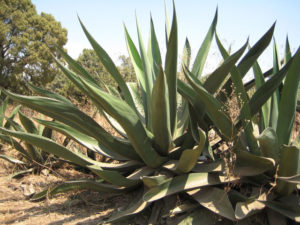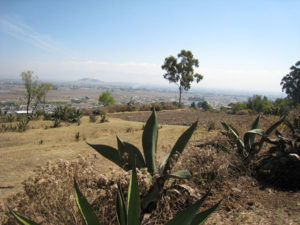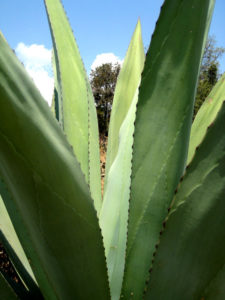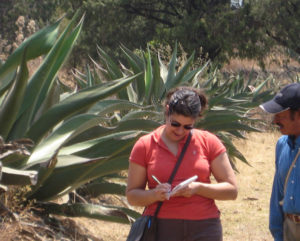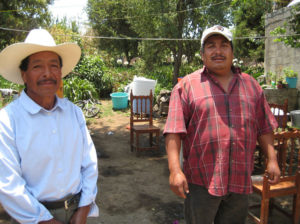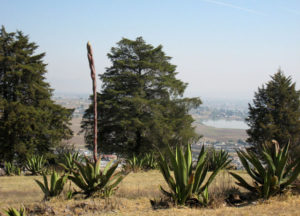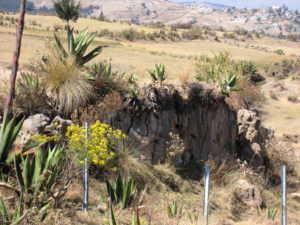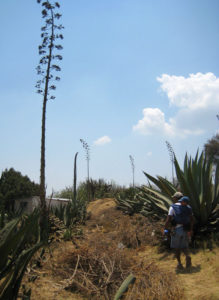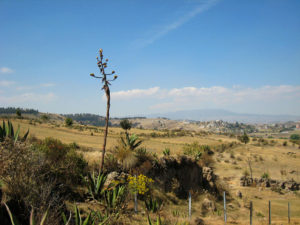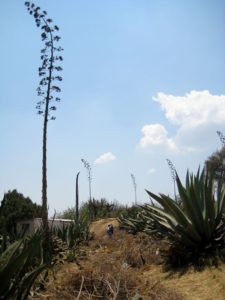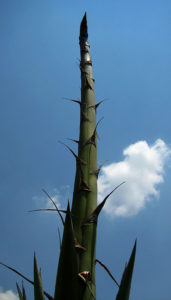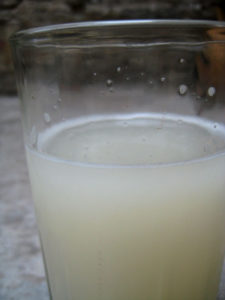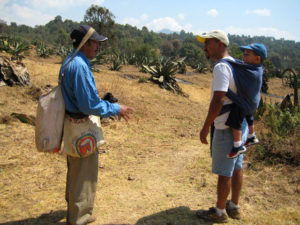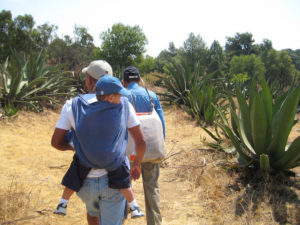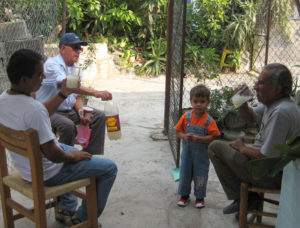Part One: Pulque and the people of Mexico
A magical plant of Mexico
A long time ago, before the Spaniards came and changed everything, the people of the Mexican highlands cultivated maguey plants. Like the people, the magueys are native to the cool, dry, high elevation climate. The plants grew well and were useful for many things.
Today, the various varieties of these agaves are sometimes called “century plants” in English, but in the language of the people, the plants were called “metl” and this may later have given Mexico the first syllable of its name. In those days, there were magueys growing along the edges of all of the fields.
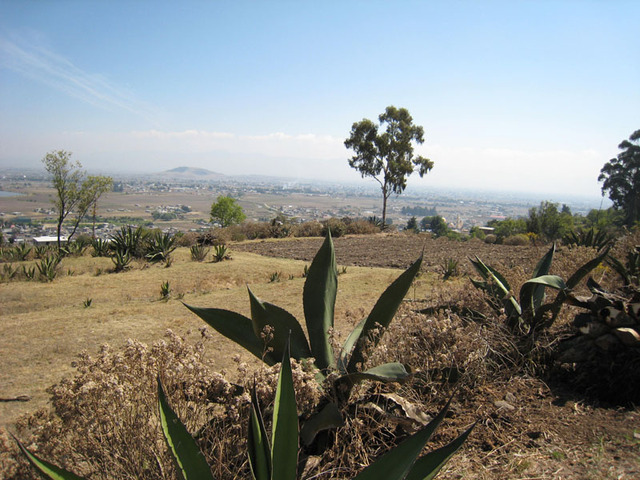
The fields were small by today’s standards, since each one was cultivated by hand rather than with horses or machinery, and there was a lot of space for magueys. Back then, the people valued the maguey very highly and no one could have imagined that today’s younger generation would let the magueys begin to die out when their grandparents passed on, nor could they have imagined that some day the maguey would be the victim of “classist” attacks on one of its products.
Magueys grow as tall as a man and are many times as wide.
A long time ago, their thick curved leaves provided people with roofing and wall material for their houses, fuel for cooking fires, channels to conduct water, and plates for serving food. Their sharp spines were used as nails and needles. Their fibers were woven into materials of differing qualities for clothing, blankets, containers, twine, rope, and scrubbers for therapeutic sweat baths, called temazcales. Their skins or fibers were used to wrap meat to be steamed, creating delicious mixiotes and even used for recording written information. Their flowers and stems were eaten. Caterpillars that eat the flesh of their core and roots provided a nutritious delicacy. Maguey sap, called aguamiel, was extracted and used as a sweetener or fermented to make a mildly alcoholic drink that they called octli. Today octli is called “pulque.”
Pulque is often the brunt of jokes about its viscosity, which is caused by the byproducts of the sugar digestion process of one of the bacteria naturally present in aguamiel (Lotter). I recommend that you don’t let pulque’s thick texture stop you from trying it.
Pulque in the community
Originally octli was a special drink, consumed regularly only by community leaders, older people, pregnant and nursing mothers, babies, and children. Sick people and women in labor could also drink it for its healing properties. “El pulque en la cultura prehispánica era respetado y sobre todo muy valorado” [“In pre-Hispanic culture, pulque was very respected and, above all, highly valued.”] (Gastronomia Tlaxcalteca)
If someone drank too much octli, it was said that 400 rabbits would invade his or her head and cause craziness. Punishments for drinking pulque to become drunk ranged from head shaving, being ostracized to different extents, and even included being put to death.
During colonial times, these community controls were lost, and pulque was widely consumed. In the seventeenth century, the Jesuits began to produce pulque in their haciendas to finance their schools. Throughout the nineteenth century, a pulque boom gathered speed. Production drastically increased, particularly in the states of Tlaxcala and Hidalgo, after Mexico gained independence from Spain in 1821 and later, with the construction of a railroad in 1866 that connected the state of Veracruz with the capital via the state of Hidalgo. The railroad allowed haciendas in the state of Hidalgo to fill the demand in the capital; in 1886, Mexico City was home to more than 800 pulque bars. Huge pulque haciendas were formed and boomed. There were at least 250 in the state of Hidalgo, which became the richest state in Mexico during its pulque heyday.
Today, pulque is rarely consumed, and outside Mexico City the few who enjoy it are generally poor and live in rural areas in the central highlands. Even in Mexico City, pulque bars are quickly disappearing. People from Mexico City, who like it, often don’t drink it unless they are traveling through the smaller towns in the mountains surrounding the city and make a special stop for pulque.
A study published in Cambridge journals concluded that while modern-day modest consumption of pulque may be beneficial due to its micronutrient content, heavy consumption of pulque during pregnancy was connected to smaller infant size and poorer mental performance.
The best of the last tlachiqueros
A special stop for pulque
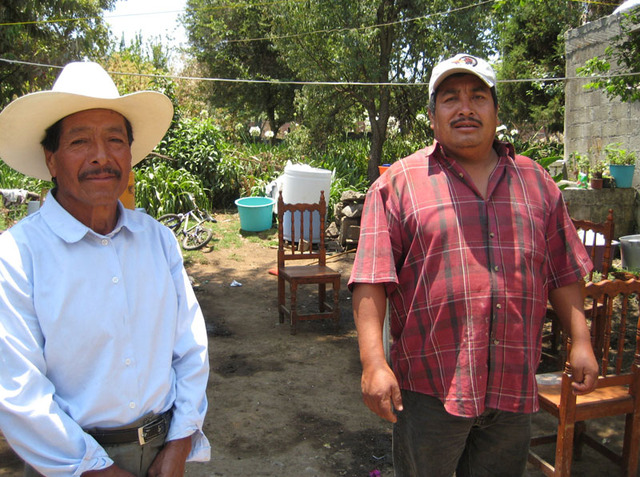
The road from Cuernavaca takes us up into the mountains, out of the state of Morelos and into the state of Mexico, to a quiet town called Ocuilan. In Ocuilan, we navigate — by the tried and true Mexican method of rolling down the window and asking — to the neighborhood called Barrio de Santa Maria. Once there, we are directed to a tortilla shop and, once at the shop, we ask for Don David. The quiet woman in the shop eyes us, and then informs us that he is out, but will be back shortly. We head to the local tianguis (open air market) to kill time until he returns. On the way there, we encounter Don David and his wife, who is cuddling the youngest of their children, a tiny infant, on her lap in their pickup truck. Don David tells us that he has one more stop to make in their errands, so we agree to meet back at his driveway in 30 minutes.
A half hour later, we are sent to the house at the back of the property and are greeted by Don David, his father, Don Joaquin, and Don David’s wife. As Mexican custom dictates, they scramble to make us welcome, providing a chair for each person out front of their little house despite the unplanned nature of our visit. Don Joaquin excuses himself quietly, heading down the driveway with a plastic pitcher. While we make our introductions, our two-year old invades their house and tries to comfort their baby when she cries. Don David’s wife is warm and kind — not at all bothered by his interest in her littlest (the others are at school).
Meanwhile, it turns out that Don Joaquin has gone to buy pulque from another producer because their own daily production isn’t quite ready. I am willing to bet that this attention to quality is what makes their pulque stand out. Ironically, as we taste the purchased pulque, we all find that we don’t like it. It’s sour. That’s when Don Joaquin gets out a glass and tastes for himself. He agrees; it’s sour. Additionally, he points out that it’s too thin. They decide to break into their own pulque and we all taste-test that. The comparison of the two pulques becomes the basis for an in-depth discussion on how a good pulque is made.
This is an unusual occurrence in central Mexico, where people more commonly accept things as-is, rarely criticizing. It is Don David’s wife, contributing more and more frequently and boldly as the conversation develops, who provides much of the specific information about pulque production.
From the heart of the maguey comes pulque
Generally speaking, producing pulque is a little like caring for a sourdough starter. It is a process of natural fermentation that must be kept in balance by consistent care of the stock. The tlachiquero — the person who harvests aguamiel (sap) — must collect the sap aguamiel from his maguey plant two times a day, and three times in the hot season. Aguamiel is thin and tastes sweet with a hint of that bitter flavor that aloe vera juice has. When Don David returns to the house, the aguamiel is added to the pulque vat and allowed to ferment before it is consumed.
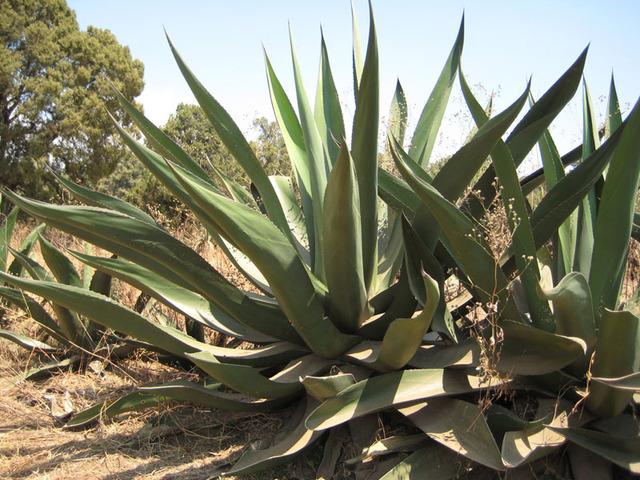
Since the magueys are often in an agricultural plot some distance from the house, the tlachiquero walks, rides a horse, or brings a burro, bringing jugs with lids on them to transport the aguamiel. In the case of Don David and his father, the travel time on horseback is about 45 minutes to get to their field. They generally have six to ten actively producing magueys at a time and usually collect two to three liters from each, twice a day. Since it takes approximately ten years for an individual maguey plant to mature, they have 200 to 250 magueys in their field.
Don Joaquin told us that there are a number of maguey species and that each one produces a pulque of a different flavor and consistency. The names of maguey varieties appear to vary from region to region, and he calls the three varieties that he prefers, Chalmeca, Malinalqueño, and Verde.
While, there are no set preferences about men and women’s roles in pulque making, in Don David’s family, it is clear that his wife’s dedication to producing good pulque affects the consistent high-quality of their product. She tells me that she has grown up producing pulque for her family’s consumption. For her, caring for a vat of pulque is as normal a part of life as making tortillas daily. After listening for a while to the discussion about how to make excellent pulque she finally interjects specific information that takes the discussion to a higher level.
She confidently tells us that a good pulque has to be actively fermenting and should be slightly foamy. If it’s too, foamy, though, it’s an indication that the producer has added something to it, such as baking soda and water in order to “stretch it” and get more out of it. The smell should be “natural,” which to the author is yeast-like, though Don David’s wife doesn’t agree with this description. Pulque is such a consistent part of her life that she can’t think of words that describe what it is like — it’s just pulque.
It normally takes a few hours after the aguamiel has been added for that day’s pulque to be ready for consumption. This is the reason that Don Joaquin had gone for pulque at another house. They had only recently added the aguamiel to their own vat. She tells us that if you want to hurry your pulque you can put it in the sun. Once your pulque is ready, you should remove about fifty percent of the total volume and store it in clean containers in the fridge so that the fermentation process is slowed and the pulque will last a number of days. If you don’t remove some every day, the pulque will get strong and can go bad and get smelly. On the other hand, if you remove too much, there won’t be enough live cultures in the vat to ferment your next day’s aguamiel.
Obviously, good pulque takes consistent care and attention on a daily basis and her efforts have been such that the author — who generally avoids alcoholic beverages — has traveled an hour and a half to find the pulque produced in her house. If we should learn one thing from Don David and his family, it’s that all pulque is not created equal and so, if you don’t happen to like the first pulque you ever taste, don’t be afraid to sample a few others.
Pulque does its work: Cementing social networks
Don David and his family send us off with over a liter of pulque they won’t charge for and plenty of hugs and well wishes. As we slowly drive through Ocuilan we sigh the contented sighs of people who have new friends.
After getting home from Don David’s house, we have to figure out what to do with all that pulque they have given us. It is too much for my husband, and I have had my fill for a good while. We stick it in the fridge as per Don David’s wife’s instructions and my husband does what any good Mexican would do. He tells our nearest neighbors that he has some pulque to share. They quickly clear their afternoon agendas and appear in front of our house where we provide chairs, just as Don David’s family did for us earlier in the day.
The men sit in the shade, chatting and sipping their glasses of cold pulque, relaxing while strengthening the social bonds that make Mexican society strong. They are helpful neighbors who have been available at a moment’s notice when we’ve needed a hand with a project or in emergencies. “So that’s what pulque’s for,” I think to myself. I need fear no backed up toilet, water shortage, or wind-blown roof tiles, common problems with Mexico’s ad-hoc infrastructure and building environment. Pulque has helped strengthen our link to a small pool of insurance labor.
To Part Two: Classist forces target pulque

